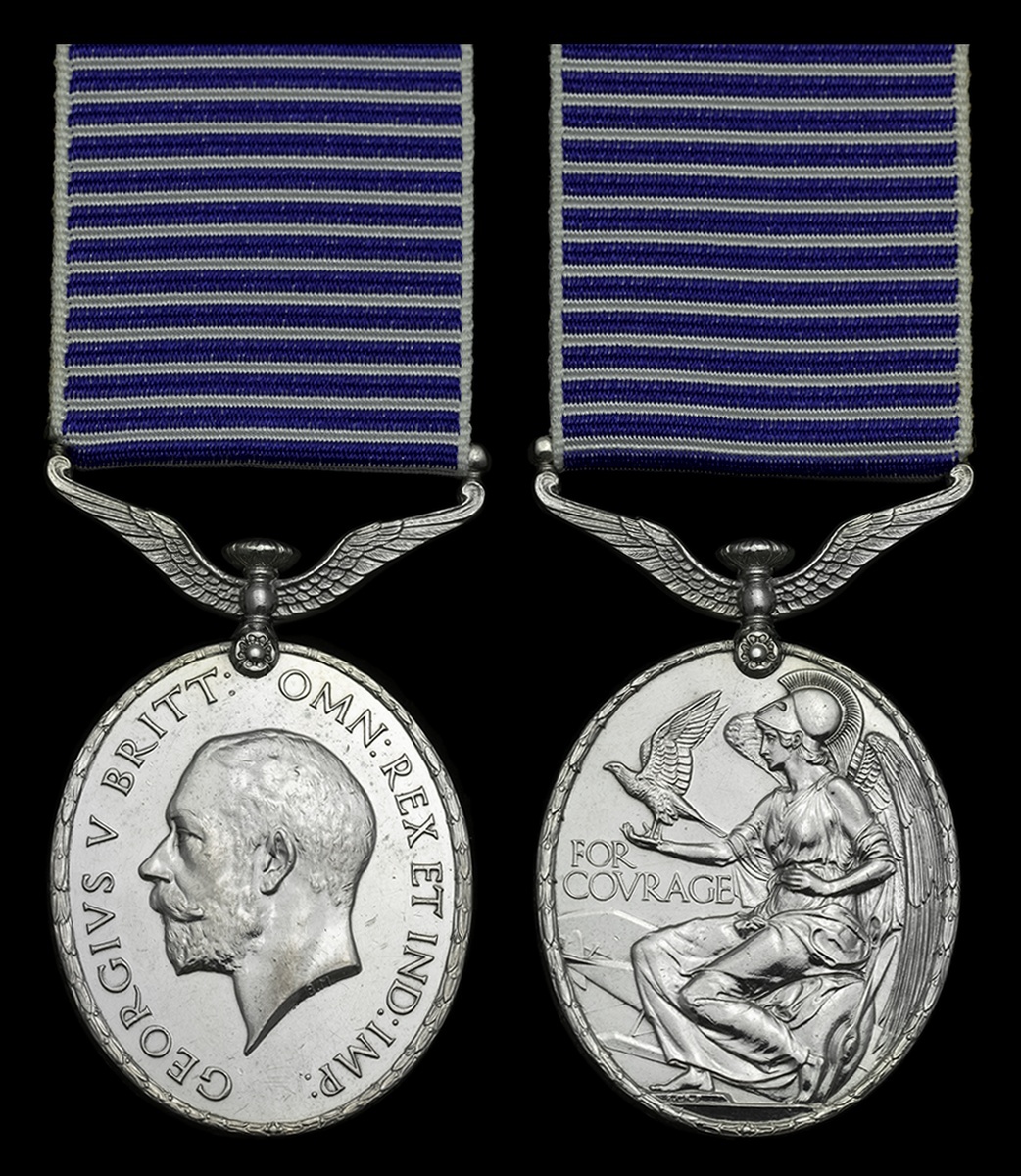
Auction: 24003 - Orders, Decorations and Medals
Lot: 219
The Great War Distinguished Flying Medal awarded to Air Mechanic A.E. Clarke, Royal Air Force Late Royal Naval Air Service, one of the first two D.F.M.'s ever awarded in June 1918, for dropping bombs on enemy submarines by seaplanes
Distinguished Flying Medal G.V.R. (F/9689 A.M. (W/.T.) Clarke. A.E. R.A.F.), good very fine
Approximately 104 D.F.M.'s awarded during the Great War, with Clarke's award being the very first gazetted on 3 June 1918 when the award was instituted.
D.F.M. London Gazette 3 June 1918, the official citation states:
'Has been employed flying as an observer for nine months, during which period he has rendered valuable services, on two occasions he dropped bombs over enemy submarines.'
Albert Edward Clarke was born at Leyton, Essex on 31 August 1898. A fitter & turner he enlisted in the Royal Naval Air Service as a boy mechanic (WT) on 1 December 1915 subsequently promoted to Air Mechanic II on 31 August 1916, his eighteenth birthday. He initially served at home-based shore establishments including President II and Daedalus before being posted to Egmont, the Royal Navy and seaplane shore base in Malta on 24 February 1917.
Two illuminating entries extracted from the Malta base Intelligence Reports illustrate typical patrols carried out by Clarke and his Pilot:
'On the 20th August 1917 information was received from the war staff at 08.08 am that a convoy, some 30 m S.E. of the island had sighted a submarine at 8.10 am. F.B.A. N 1077 (Italian 160 H.P. Isotta Fraschini), Pilot F.L.W.M. Tait, Observer A/M Clarke left the base and sighted the submarine about 33 miles S.E. of Malta, 3 miles ahead. The submarine dived immediately on sighting the seaplane, leaving an oily patch on the water. One 65 lb bomb with a .25" delay action fuse was dropped on the anticipated position of the submarine, and the explosion photographed but no further results were observed.'
'On February 3rd 1918, short seaplane No. N. 1497 - Pilot F.S.L. Picken, Observer A.M. Clarke - left on patrol at 15.55. The pilot reports that upon leaving the base he steered South for 32 miles and then changed East and steered on this course for 12 miles. He then changed his course to the North. After steering on this course for 5 miles, the observer sighted a submarine. Upon approaching this position, a thin streak of heavy oil was seen on the surface. On passing over it the observer dropped a calcium flare and then saw a submarine submerged fully 60 feet, steering a westerly course; he was however too late to drop a bomb, but on approaching it a second time, a 230 lb 2 ½ sec. delay bomb was dropped which exploded 10 feet short. W/T signal was at once sent to Base informing them of the position of the submarine. Another flare was then dropped so that the submarine was between the two. A second 230 lb bomb was dropped and exploded between the two flares, the machine was then in position 3532.1447E, the time being 16.49. Wind West 25-30 knots.
Two photographs were taken, the first at 16.50 at a height of 800 feet of the submarine: the second of the disturbance and bubbles on the surface after the explosion, taken at 16.52 from 800 feet. The pilot then encircled the position for 30 minutes, but all that could be seen were large air bubbles and patches of oil which came to the surface during the first minute or two. The machine then returned to base, arriving at 18.25.'
The Malta base Armament Report for March 1918 records the bombing of an enemy submarine on a further occasion by Clarke and his pilot.
'On 11 March 1918 a 65 lb bomb was dropped 10 feet to the right of an 80-foot submerged submarine. The bomb was observed exploding wide of the target.'
Clarke was promoted to Flight Lieutenant and given a temporary commission as 2nd Lieutenant (Observer) on 27 August 1918. Additionally awarded a Silver War Badge, he was discharged medically unfit on 14 February 1919.
Not finished with active service Clarke rejoined the Royal Air Force on 26 October 1939 as a Pilot Officer, Admin branch. His final appointment was in the Technical Branch (Signals) having risen to Squadron Leader by the end of the conflict. Clarke died in Surrey in October 1970.
Subject to 20% VAT on Buyer’s Premium. For more information please view Terms and Conditions for Buyers.
Sold for
£2,000
Starting price
£1100




